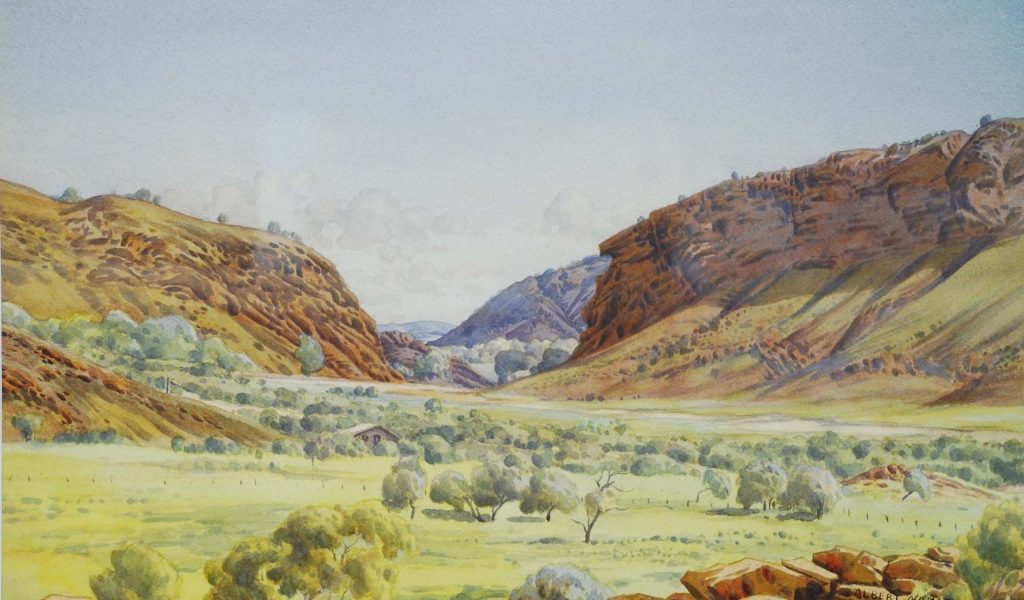Albert Namatjira (1902 – 1959)

Albert Namatjira Heavitree Gap, Ngurratjuta Collection, Alice Springs
Albert Namatjira is one of Australia’s great artists, and perhaps the best known Aboriginal painter. His western style landscapes – different to traditional Aboriginal art, made him famous. Fame led to Albert and his wife becoming the first Aborigines to be granted Australian citizenship. It was a significant achievement, because at this time Aborigines had few rights. He wasn’t born Albert Namatjira. His parents called him Elea. But after moving to an Aboriginal mission (Hermannsburg) and adopting Christianity, they baptised and renamed their son.
Mission life was nothing like the life Albert Namatjira’s people lived in the deserts of the Northern Territory. That was a lifestyle he knew little about, until he turned thirteen. At the age of thirteen Albert experienced an important Aboriginal ritual – initiation. As one of the Aranda group, he lived in the bush for six months and was taught traditional laws and customs by tribal elders. Work as a camel driver took Albert through the country he would later paint, the dreamtime places of his Aranda people.
By this time he had married Ilkalita, a member of a neighboring community. The couple built a house near the mission, and Albert supported his growing family by doing odd jobs. These included making and selling small pieces of artwork. In 1934 two Melbourne artists visited the mission to exhibit their paintings. Seeing them, Albert Namatjira was inspired to paint seriously. Two years later, he volunteered to show one of the painters, Rex Batterbee, good places to paint. In exchange, Rex taught Albert how to paint. Albert was a fast learner. He thought he had a natural gift, and he was right. Albert’s first exhibition, held in Melbourne in 1938, sold out. Exhibitions in Adelaide and Sydney drew similar enthusiasm. Even the Queen liked his work
Albert Namatjira was a celebrity, but not always a comfortable one. It was always a relief for him to leave the big smoke and return to his desert home. Success brought money – and Albert planned to use it to secure a future for his family. He wanted to lease a cattle station – but as an Aborigine he wasn’t allowed.
Next he tried to build a house in Alice Springs. Once again the law prevented him, just because he was Aboriginal. It was a strange situation. Here was a man, heralded as a top artist, treated like a celebrity and yet not even allowed to own land. “He was definitely the beginning of a recognition of Aboriginal people by white Australia.” Charles Perkins
Public outrage at Albert’s predicament pushed the government to grant him and his wife full citizenship in 1957. This meant they could vote, enter a hotel and build a house anywhere they chose. It took ten years for the government to grant similar rights to the rest of the Aboriginal population.
As a citizen Albert Namatjira could now also buy alcohol. In keeping with Aboriginal custom, Albert’s friends expected him to share any alcohol he bought. But in doing this he broke white man’s laws. In 1958, police charged Albert with supplying alcohol to Aboriginal people. He denied the charge, but the court didn’t believe him. After two months in prison, Albert emerged a free, but broken man. He had lost his will to paint, and to live. Albert Namatjira died in 1959. He was just fifty-seven years old.
Albert Namatjira’s life and work have inspired other Aboriginal people to paint. Among them have been his children and grand-children. This great painter captured Australia’s heart in artwork and was praised around the world. His life showed white Australians the injustice of racist laws, and contributed to long overdue changes for his people.
Source: abc.net.au